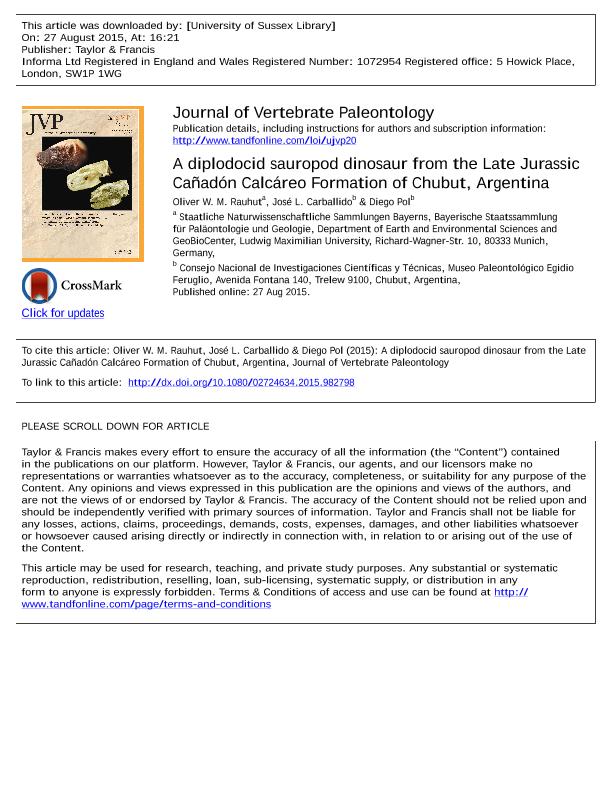Mostrar el registro sencillo del ítem
dc.contributor.author
Rauhut, Oliver Walter Mischa

dc.contributor.author
Carballido, José Luis

dc.contributor.author
Pol, Diego

dc.date.available
2018-05-03T15:12:44Z
dc.date.issued
2015-10
dc.identifier.citation
Rauhut, Oliver Walter Mischa; Carballido, José Luis; Pol, Diego; A diplodocid sauropod dinosaur from the Late Jurassic Cañadón Calcáreo Formation of Chubut, Argentina; Society of Vertebrate Paleontology; Journal of Vertebrate Paleontology; 35; 5; 10-2015; 1-8; e982798
dc.identifier.issn
0272-4634
dc.identifier.uri
http://hdl.handle.net/11336/43949
dc.description.abstract
Late Jurassic dinosaur faunas from the Southern Hemisphere are still poorly known, and it thus remains unclear whether or not the famous Tendaguru fauna (Kimmeridgian–Tithonian, Tanzania) represents a typical Gondwanan dinosaur assemblage of that time. In South America, only the Oxfordian–Kimmeridgian Cañadón Calcáreo Formation of Chubut Province, Argentina, has yielded more than isolated Late Jurassic dinosaur remains so far. Here we report fragmentary remains of a dipolodocid sauropod from this unit, representing the first record of this family from the Late Jurassic of South America. Incorporating the basal macronarian Tehuelchesaurus, an unidentified brachiosaurid, the dicraeosaurid Brachytrachelopan, and the diplodocid described here, the taxonomic composition of the sauropod fauna from the Cañadón Calcáreo Formation is remarkably similar to that of the Tendaguru Formation, but also to roughly contemporaneous faunas in North America and Europe. The diverse non-neosauropodan sauropod fauna known from the early Middle Jurassic (Aalenian–Bajocian) of the same depositional basin within Chubut Province is congruent with the dominance of non-neosauropodan sauropods in continental faunas globally to at least the Bathonian. These assemblages suggest a rapid faunal turnover within sauropod faunas in the late Middle Jurassic-earliest Late Jurassic at least in western Pangea, through which basal eusauropods were replaced by diplodocoid and macronarian neosauropods. Taking paleogeographical reconstructions into account, this faunal replacement might have taken place in a surprisingly short time interval of maximally five million years close to the end of the Middle Jurassic.
dc.format
application/pdf
dc.language.iso
eng
dc.publisher
Society of Vertebrate Paleontology

dc.rights
info:eu-repo/semantics/openAccess
dc.rights.uri
https://creativecommons.org/licenses/by-nc-sa/2.5/ar/
dc.subject
Diplodocid
dc.subject
Neosauropoda
dc.subject
Jurassic
dc.subject
Patagonia
dc.subject.classification
Meteorología y Ciencias Atmosféricas

dc.subject.classification
Ciencias de la Tierra y relacionadas con el Medio Ambiente

dc.subject.classification
CIENCIAS NATURALES Y EXACTAS

dc.title
A diplodocid sauropod dinosaur from the Late Jurassic Cañadón Calcáreo Formation of Chubut, Argentina
dc.type
info:eu-repo/semantics/article
dc.type
info:ar-repo/semantics/artículo
dc.type
info:eu-repo/semantics/publishedVersion
dc.date.updated
2018-05-02T18:13:34Z
dc.journal.volume
35
dc.journal.number
5
dc.journal.pagination
1-8; e982798
dc.journal.pais
Estados Unidos

dc.journal.ciudad
Lawrence
dc.description.fil
Fil: Rauhut, Oliver Walter Mischa. Ludwig Maximilians Universitat; Alemania
dc.description.fil
Fil: Carballido, José Luis. Museo Paleontológico Egidio Feruglio; Argentina. Consejo Nacional de Investigaciones Científicas y Técnicas; Argentina
dc.description.fil
Fil: Pol, Diego. Museo Paleontológico Egidio Feruglio; Argentina. Consejo Nacional de Investigaciones Científicas y Técnicas; Argentina
dc.journal.title
Journal of Vertebrate Paleontology

dc.relation.alternativeid
info:eu-repo/semantics/altIdentifier/doi/http://dx.doi.org/10.1080/02724634.2015.982798
dc.relation.alternativeid
info:eu-repo/semantics/altIdentifier/url/https://www.tandfonline.com/doi/abs/10.1080/02724634.2015.982798
Archivos asociados
